More transparency needed to ensure EU recovery funds are well spent

EU citizens deserve to know more about how Recovery funds are spent and who benefits, write Krzysztof Izdebski and Dragoș Pîslaru.
Krzysztof Izdebski is co-lead of the Open Spending EU Coalition, Dragoș Pîslaru is a Renew Europe MEP and the European Parliament’s Co-rapporteur on the Recovery and Resilience Facility (RRF).
We’re two years into the landmark EU Recovery and Resilience Facility (RRF), with €672.5 billion being handed out to member states to recover the economic losses, foster resilient societies, and bring prosperity and better public services to Europe in the wake of the pandemic. While this money is being committed and spent, there is little accountability and transparency on what it is buying – and from who.
But this is critical to ensure the RRF delivers in making European economies and societies more sustainable, resilient, and better prepared for the challenges and opportunities of the green and digital transitions.
Despite the requests of the European Parliament during the RRF negotiations for transparency and clear understanding of the distribution of funds in order to tackle the dismal track record of corruption and misspending in EU funds, the final version of the regulation did not fully commit member states to rigorous reporting and public oversight requirements on these loans and grants. This was mainly due to the reluctance of the Council at that stage, invoking the lack of time for national governments to coordinate their databases, as well as extra administrative burden and pressure on national authorities.
Due to the REPowerEU proposal that made amendments to the RRF Regulation, a new opportunity emerged for the European Parliament to negotiate this provision once more. Building on the efforts of the civil society organisations, among others, the Open Spending EU Coalition, EU legislators recently mandated national governments to publish a list of 100 recipients receiving the highest amount of funding. With updates planned once every six months, the list will include the data about the recipient’s legal name and the amount of funds received.
This is a small but positive step to fully allow civic actors, businesses, academics, the media and civil servants, to use the information to understand where the funds are going. It may prove to be not timely enough to spot risks to investigate or opportunities to save money or improve the goods and services citizens are getting.
The technology exists for governments to share real-time data about the entire funding process, from planning to contract execution, including final recipients, as open data. Some countries are already doing an excellent job of this of their own volition. But without clear guidance from the European Commission, there is a big disparity between what information governments are sharing and how accessible it is.
New research on 10 EU member states reveals that Bulgaria, Estonia, and Lithuania are leading in terms of how much and how well information is published. These countries have central portals containing all available public information about public spending from the planning process to contract execution, including participating entities, financial information and changelogs. Other nations have settled on complying with the low bar set by the EU guidance.
Consequently, there remains a significant risk of irregularities, corruption, and waste. Compared with the Open Spending EU Coalition’s recommended transparency standards, the 10 member states publish just under 60% of information needed to follow the money. Without more complete, quality information disclosure, it’s not possible to evaluate an accurate level of risk in the remaining 40% of data.
Beyond the advantages of transparency for preventing corruption and misuse of public funds, transparency of EU budget funds should be part of the idea of a common market. It is downright impossible to assess the effectiveness of European policies when not only the EU institutions but also independent experts have been unable to estimate how much money is spent on their implementation in each country.
In place of the ineffectiveness of control and analysis at the national level, EU institutions should prioritise creating an enabling framework. Driven by open, timely data, this framework would incentivise innovation among member states and allow them to compare results achieved with their investments. It would empower civil society organisations (CSOs) and journalists to keep a more effective eye on EU taxpayers’ money.
When there is a willingness to be progressive at the member state level, anything is possible. The EU can still guarantee and harmonize greater transparency, raising the bar for those countries that have chosen to shun better practices.
EU legislators should pursue a comprehensive policy of uniform obligations to publish information about its budget spending. This can be done by amending the Financial Regulation and including the Public Spending & Public Procurement category as a High-Value Dataset under Article 14 of the Open Data Directive. It should also introduce a clear standard for disclosing the relevant personal data about those who benefit from RRF funds. While the European Parliament is and has pushed already for transparency, the Council needs to get on board as well.
Even without a new legislative push, the European Commission should create a systemic framework at the EU level to enable member states’ authorities responsible for publishing data on public spending to share experiences.
We are talking about a huge amount of money, borrowed from the markets, which will be paid back by the next generations. It should not be too much to ask for adequate data collection as a minimum requirement. Every EU citizen should be able to access and consult data in one public online place about reforms and investments done through the RRF and that will impact their lives.



